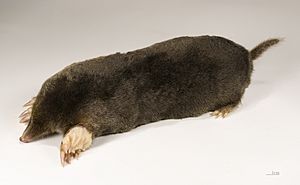Taupe facts for kids
Quick facts for kids Taupe |
|
|---|---|
| Color coordinates | |
| Hex triplet | #483C32 |
| Source | ISCC-NBS |
Taupe is a cool color that mixes dark gray and brown. The name comes from the French word taupe, which means "mole". Imagine the color of a mole's fur! At first, the word "taupe" only described the average color of the European mole. But since the 1940s, people started using it for many different shades that look similar.
Taupe can be a bit tricky to describe because it covers a wide range of colors. It often looks like a grayish-brown or a brownish-gray. It's a color that's hard to say if it's truly brown or truly gray. Even designers and artists sometimes have different ideas about what "taupe" really means!
The word "taupe" was first used to describe a color in English in the early 1800s. By 1911, it was officially recorded in the Oxford English Dictionary.
Contents
What is Taupe?
Taupe (#483C32)
#483C32

Taupe colors are usually a mix of dark tan, grayish-brown, or brownish-gray. The word comes from the French word taupe, which means "mole" (the small mammal that lives underground). This is why the color often reminds people of earth and nature.
Originally, "taupe" was just the color of the European mole. But over time, just like with colors like pink or lavender, the meaning grew. Now, it includes many different shades that have that special gray-brown look.
Because it's so flexible, taupe can be used in many ways. It's a popular color in fashion, home decor, and art because it's neutral and calming. It can look different depending on the light or the colors around it.
In 1930, a book called A Dictionary of Color set a standard for many color names. The color shown here is what was considered "taupe" back then. Today, people might use "taupe" for lighter shades too, so this specific color is sometimes called dark taupe.
Different Shades of Taupe
Taupe isn't just one color! It has many interesting variations, each with its own special touch. Let's explore a few of them.
Pale Taupe (Mouse)
This shade is a very light taupe, often described as a "mouse" color. It's a soft, light gray-brown, much like the fur of a small mouse. The name "mouse" for a color has been used in English since 1606!
Light Taupe
| Light Taupe | |
|---|---|
| Color coordinates | |
| Hex triplet | #B38B6D |
| Source | Crayola |
This is a lighter version of taupe, sometimes called dark tan. You might find this color in Crayola colored pencils. It's a warm, gentle brown with a hint of gray.
Mauve Taupe
| Mauve Taupe | |
|---|---|
| Color coordinates | |
| Hex triplet | #915F6D |
| Source | ISCC-NBS |
Mauve taupe adds a touch of mauve (a pale purple-pink) to the classic taupe. This gives it a slightly purplish-reddish tint, making it a unique and interesting shade. This color name first appeared in English in 1925.
Deep Taupe
| Deep Taupe | |
|---|---|
| Color coordinates | |
| Hex triplet | #7E5E60 |
| Source | Pantone TPX |
Deep taupe is a richer, darker version of the color. It has a strong grayish-reddish tone, making it feel warm and earthy. This specific shade comes from the "Pantone Textile Paper eXtended (TPX)" color list, which is used by designers around the world.
There are many other shades of taupe, like rose taupe, sandy taupe, taupe gray, taupe brown, and taupe beige. Each one offers a slightly different mix of gray, brown, and other colors, showing how versatile taupe can be!
Related pages

